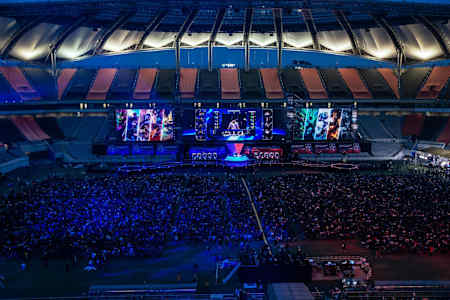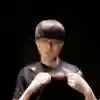Gaming

Esports
League of Legends ranking system explained
Understand what LP, MMR and decay are so you can climb the LoL ranked ladder all the way to Challenger and stand alongside the pros.
Ranked mode in League of Legends is one of the most challenging yet thrilling experiences a gamer can have. It’s where the best players test themselves and rack up victories to climb up to the highest division possible.
Every LoL player dreams of reaching Challenger and garnering enough recognition to become a professional player, but everybody has to start somewhere. It can be intimidating and overwhelming, especially if you don’t know how LoL ranked works or what LP is, but this article will answer any questions you have.
01
What is LoL Ranked?
In any other sport, you play against those who are of a similar skill level to yourself. League of Legends isn’t any different, which is why the ranking system is in place.
Ranked mode allows players of equal calibre to play against each other to create close, exciting games rather than one-sided massacres where a LoL veteran immediately outwits an introductory player.
02
What are League of Legends Tiers and Divisions?
LoL's ranking system is made up of 10 tiers and within most of those are a total of four divisions. Once any player reaches level 30 in League of Legends and owns 16 champions or more, they are eligible to play their ranked placement games. After an initial five provisional games, a player is placed into a tier and division likely somewhere in Iron, Bronze, or Silver tier although it's possible to achieve a Gold or Emerland rank depending on the number of games you've won so far.
03
All League of Legends Tiers
The 10 tiers, or ranks, in League of Legends starting from lowest to highest are: Iron, Bronze, Silver, Gold, Platinum, Emerald, Diamond, Master, GrandMaster, and Challenger.
The majority of LoL players find themselves in the introductory tiers of Iron, Bronze, Silver, and Gold for quite a while, which is a testament to how difficult it can be to rank higher in the game.
Within each tier between Iron and Diamond are divisions numbered from four (IV) to one (I), with one being the highest. The final three tiers, Master, GrandMaster, and Challenger, are known as the Apex Tiers and are not divided.
Your gameplay determines which division you're placed in and how much LP (League Points) you start with. Winning earns you more LP whereas losing loses you some LP. To move up through divisions and, ultimately, among tiers, players need to earn a total of 100 LP to automatically advance to the next division.
04
Reaching the Master, GrandMaster and Challenger Tiers
Players who fight their way through all previous divisions will arrive in the Master tier. Added to the game in 2014, Master is the last hurdle players must overcome to reach the final two tiers - GrandMaster and Challenger. GrandMaster was added in 2018 to account for the discrepancy in skill level that Riot noticed among its Master players.
The addition of these two tiers also reflects an effort from Riot to create transparency in ranked standings. Since Challenger exclusively hosts the top 300 Solo/Duo queue and 200 Flex 5v5 players in a region, players will now move from Diamond I to Master and will be matched solely with players in the Apex Tiers.
Once they've reached Master tier or above, players compete for total League Points (LP). Calculated the same way as in other tiers, a player's total LP determines their position in Master tiers and above. Every 24 hours, players ranked as Master or GrandMaster have the opportunity to move into the next tier, bumping someone else out of a higher tier if they surpass them in LP. This allows top-tier players to see their positions much easier and immediately determine just how close they are to reaching the next level.
Challenger Tier is where the very elite play with a minimum of 500 LP needed to enter. This tier is home to pros and aspiring pros alike. Reaching Challenger puts a player on the radar of pro teams, and if a team needs a substitute or a replacement, this is where they can be found.
The best of the best compete at the League of Legends World Championship
© SonStar/Red Bull Content Pool
05
LoL's ranking distribution
League of Legend seasons take place across a year, separated into three splits. Split 1 begins in January, Split 2 begins in May, and the newly added Split 3 will start in September. There is no longer a preseason. The end of each split offers potential rewards and a small rank reset by around three or four divisions.
Here is the most recent LoL ranked distribution of players across the different tiers for solo play:
- Iron: 6.9%
- Bronze: 18%
- Silver: 18%
- Gold: 20%
- Platinum: 19%
- Diamond: 4.1%
- Master: 0.041%
- GrandMaster: 0.060%
- Challenger: 0.022%
This distribution tends to remain relatively similar year after year, with most players finding themselves with a Bronze, Silver, or Gold rank.
06
How LoL League Points (LP) works
Ranked wins and losses earn or lose a certain amount of League Points or LP. The amount is determined based on the difficulty of opponents and the rankings of teammates, among other factors. Once a player has earned 100 LP in their division, they immediately move up one division.
Leftover LP will rollover into your new division unless you promote into a new tier, at that point you will start in the bottom division with 1 LP. This ranking system is frequently referred to as the LoL Ranked Ladder.
While this system is simple, the ladder climb can be gruelling and harsh. If a player's LP drops to zero in a division, they will be demoted if they continue losing games. A yellow warning will be given when demotion is close and a red warning will appear if losing your next game will result in a demotion. Demotions can be discouraging and lead to players feeling stuck in a certain division.
07
How does League of Legends Ranked Decay work?
Once you reach the higher ranks in Diamond and above, if you spend long enough without competing you will start to lose LP and can even be demoted.
After 28 inactive days in Diamond, players will begin to lose 50 LP each day they remain inactive. As for the Apex Tiers of Master and above, players will begin to decay after just 14 days of inactivity and will lose 75 LP each day.
You can bank active days by playing multiple games in order to delay this. Those in Diamond can bank up to 28 active days, receiving 7 banked days per match played. Meanwhile, in the Apex Tiers, one game will provide one banked day up to a maximum of 14.
It’s also worth noting that decay-induced demotion from Master will automatically place the player into Diamond II instead of Diamond I.
08
League of Legends Matchmaking Rank (MMR) explained
Matchmaking Rank (MMR) is a hidden number Riot assigns to each player based on their skill level that determines how much LP that player gains or loses in each game. The higher a player's MMR, the more league points they stand to win in a victory and the less they are likely to lose in a defeat.
However, a player's MMR is also determined by winning or losing streaks, the average MMR of their team, and the MMR of the opponents. If a player's MMR is above average for their team, they will earn more LP in a win.
09
League of Legends Solo/Duo vs. Flex Ranked Queues
Before you start a new League of Legends game, you have the choice to play solo or with another person (duo) in the first queue or with a team of one, two, three or five in Flex. Both queues give you entirely separate and independent ranks. Since your rank may vary depending on which you choose, it's important to make the decision based on your preferred playing style.
Flex play is geared more toward players who enjoy working with a team with no rank restrictions for players in Diamond or below. Meaning even if you’re in Diamond, you could still play ranked with your friend in Iron, just don’t expect easy match-ups.
Meanwhile, solo or duo players are usually most interested in strategic gameplay that allows them to move up in tiers and within divisions based on their own skill level. The queue limitation rules here are much tighter, especially the higher you go. If you’re in Iron, you can duo queue with a teammate two tiers above you in Silver but if you’re in Diamond you’re premade teammate needs to be within two divisions of your rank.
And in the Apex Tiers of Master and above you can only queue alone. There’s no room for friends at the highest level.
League of Legends has roughly 120 million players per month, and its popularity can be largely attributed to the ranking system that keeps the game fun and challenging while allowing players to compete against others who are equally skilled.









